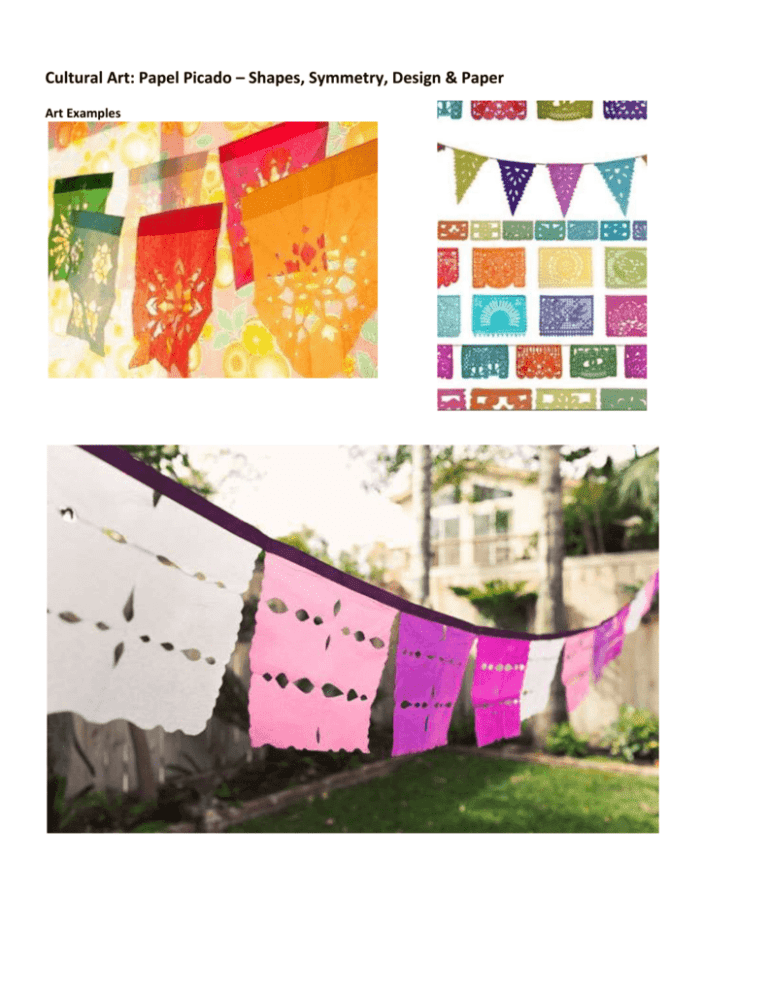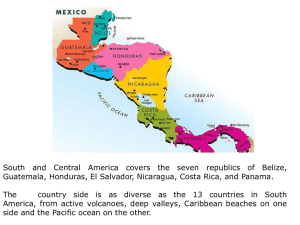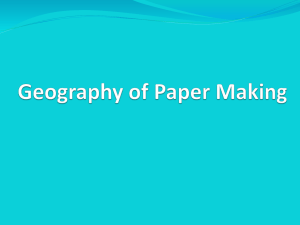Papel Picado Lesson Plan as a Word
advertisement

Cultural Art: Papel Picado – Shapes, Symmetry, Design & Paper Art Examples Project Background: Papel picado are traditional Mexican paper decorations that were made as announcements of celebrations and important events such as weddings, funerals, and holidays. The art of paper making started in China in 105 AD, that is 1,900 years ago! It spread through the world by bridging into Japan then to central Asia and eventually into Western Europe through trade routes. When the Spanish arrived in Mexico they found that the native people had invented their own paper making by squishing the pulp of bark between rocks. The Mexican people would cut the paper in different shapes as a celebration of their deities (gods which they believed in). This art form was called Aamate. This art form evolved when the Spanish brought fine paper called papel de china that was used to wrap up fragile porcelain. The tradition adopted this new kind of paper that was similar to tissue paper. Many times you will see Papel Picado up at a birthday party, Quinceañera or during Day of the Dead celebrations. During the 19th century, in the era of the haciendas, laborers purchased all of their necessities from the hacienda store. Most of these stores stocked papel de China, or Chinese paper, known in English as tissue paper. The laborers began to use the paper available to them to create elaborate decorations for their festivities, possible producing extra so that they could sell them to other haciendas. In time, the laborers developed into artisans, advancing the craft of papel picado to an art form, and passing the skill on to each new generation. Today, the descendants of original papel picado artist are still making these unique paper decorations but have included new materials such as plastic sheeting and Mylar. Using straight pins, and metal chisels, the artisans carefully carve their designs into the paper, cutting away the unneeded portions to reveal their designs. Careful thought is given as to which portion of the paper should be removed, so that the deisgn is clear, but the paper remains resilient. Papel Picado translates directly to chopped paper, or confetti. Paper is often forgotten as an art medium. All artist use paper to sketch, doodle, create and build their imagination and art work! Project Overview Materials: scissors, colored tissue paper, string, glue stick or glue bottle, clear tape, hole punch to help younger children punch out interior of a shape to cut it out. Procedures: Prep: Cut the tissue paper into manageable sizes shaped roughly like a rectangle or triangle. You can choose size for your students, younger students may do better with larger sizes of paper. Discuss Papel Picado with students in class. Also discuss pattern, design and symmetry. Give examples, and allow for students to give examples of things in nature that have patterns, designs and symmetry. Refer to images on website. 1. Students must draw out a design on regular copy or sketch paper, and experiment with folding and cutting their paper to get the desired effect. Make sure they plan which shape they want their flag to be: triangular or rectangular. 2. Using the printer paper, teach the students the basic principles of folding and cutting paper, and that by folding the paper one creates symmetrical results. 3. Students can choose a color of tissue paper 4. The students should fold their paper into square or triangular format and then draw on their desired shapes and patterns. Older students may wish to cut their own detailed designs free hand. Younger students can create larger shapes. 5. How to cut out paper: Make a small cut into each piece of the design and have the kids unfold their paper to see how well they designed their drawing. Then continue to cut out the pieces. 6. Once complete the students must fold over the top of their banner to create a space for a string to be hung. 7. Have the kids put a small line of glue in the crease of this fold and set the edges of a string in it creating a hanging device for the banners. Clear tape would also work well. 8. Hang the paper cuttings in the hallway, classroom or bulletin board in celebrations of All Saints Day or Day of the Dead, on November 1. Or hang the paper cuttings for fun and to brighten a room or a different celebration! Vocabulary Artesao-craftsman Haciendas – A large estate or house that many people lived at, usually not from the same family. The owner of the Hacienda was the boss or person incharge of the hacienda. On the estate there would be craftsmen, farm hands, laborers and other working people who lived at the large estate to create wealth for the owner by working their trade. papel de china- tissue paper papel picado- cut paper – A paper decoration usually hung and used in a celebration or event such as a wedding or holiday. This paper decoration is hand cut with various patters of shapes, designs and images. pegamiento- Spanish for glue tijeras- Spanish for scissors Pattern – A series of shapes, colors, designs or other visual elements that repeat in a set sequence or series. design Symmetrical - Symmetry is when one shape or object becomes exactly like another if you flip, slide or turn it on an axis. The simplest type of Symmetry is "Reflection" (or "Mirror") Symmetry (see images in supplemental information). Based on Utah State Visual Arts Core Curriculum Requirements (4th grade) Standard 1: The student will interpret and apply visual arts in relation to cultures, history, and all learning. Objective 1: Compare the arts of different cultures to explore their similarities and diversities. Describe why different cultures may have used different materials to create their arts and crafts. Show images of paper art in modern day Show images of international flags and note the designs and patterns within them. Objective 2: Connect various kinds of art with particular cultures, times, or places. Define folk art and describe the travel of paper art from 105 a.d. China to Mexico. Objective 3: Recognize the connections of visual arts to all learning. Describe the phenomenon of symmetry and its application to nature and math. Use the Spanish vocabulary words to expand the knowledge of non-Spanish speaking children as well as teach the importance of learning languages. Use a visual arts form as a help in expressing an idea in a nonart subject; e.g., a science project, the writing of a poem, a social studies project. Standard 1: The student will explore and refine the application of media, techniques, and artistic processes. Objective 1: Develop creative solutions and solve problems by creating a design using line, form, combinations of color, symmetry, repetition and variation of pattern Standard 3 (Expressing): The student will choose and evaluate artistic subject matter, themes, symbols, ideas, meanings, and purposes. Objective 1 Explore possible content in art prints or works of art. Determine and explore a variety of sources of inspiration for making art; e.g., panoramic view, microcosm, people, imagination, experimentation, decoration, celebration, events, interpretation of emotions, education, religion. Supplemental information Symmetry in Nature The History of Paper http://www.paperonline.org/history-of-paper Fun Family Project! Make your own Paper – http://tinkerlab.com/how-to-make-paper/ Trees & Paper – Conservation 1 ton of uncoated virgin (non-recycled) printing and office paper uses 24 trees 1 ton of 100% virgin (non-recycled) newsprint uses 12 trees A "pallet" of copier paper (20-lb. sheet weight, or 20#) contains 40 cartons and weighs 1 ton. Therefore, 1 carton (10 reams) of 100% virgin copier paper uses .6 trees 1 tree makes 16.67 reams of copy paper or 8,333.3 sheets 1 ream (500 sheets) uses 6% of a tree (and those add up quickly!) 1 ton of coated, higher-end virgin magazine paper (used for magazines like National Geographic and many others) uses a little more than 15 trees (15.36) 1 ton of coated, lower-end virgin magazine paper (used for newsmagazines and most catalogs) uses nearly 8 trees (7.68) Save the Trees – Mathematics – apply it! (1) Multiply the number of trees needed to make a ton of the kind of paper you're talking about (ground wood 12 trees or freesheet 24 trees), then (2) multiply by the percent recycled content in the paper. For example, 1 ton of 30% postconsumer content copier paper saves 7.2 trees 1 ton of 50% postconsumer content copier paper saves 12 trees.









